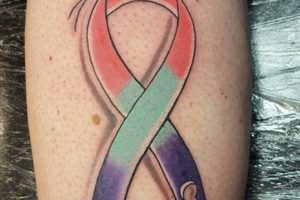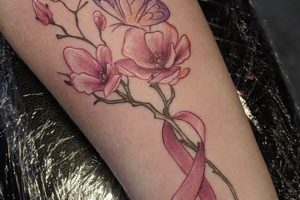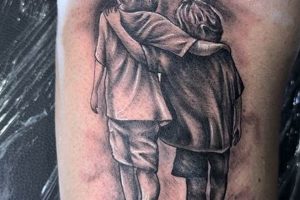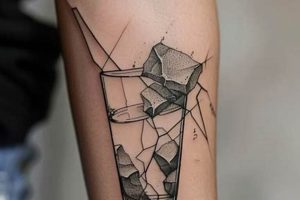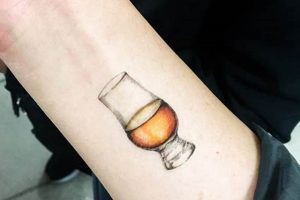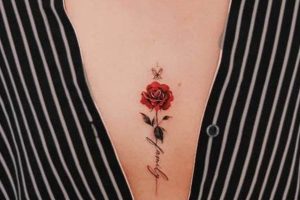Designs for body art specifically intended for the shoulder area encompass a wide range of styles, imagery, and sizes. Examples include floral motifs, intricate mandalas, animal portraits, tribal patterns, and script-based artwork. The curvature and visibility of this body part offer a unique canvas for self-expression.
Placement on the shoulder provides an advantageous blend of visibility and concealability, allowing individuals to showcase their chosen design or cover it as desired. The shoulder’s relatively large and flat surface area accommodates both intricate detail and bolder, simpler compositions. Historically, body art in this location has signified status, group affiliation, or spiritual beliefs in various cultures, adding a layer of cultural significance to contemporary applications.
Factors such as pain tolerance, desired aesthetic, and the artist’s expertise should be considered when exploring designs for this prominent location. This overview will explore popular themes, design considerations, and practical advice for selecting and maintaining shoulder artwork.
1. Placement
Placement significantly influences the visual impact and symbolic meaning of shoulder tattoos. A design that wraps around the shoulder cap creates a dynamic, three-dimensional effect, emphasizing the body’s natural contours. This placement often suits larger, flowing designs like dragons, tribal patterns, or floral motifs. Conversely, a design placed on the front or back of the shoulder offers a more contained canvas suitable for smaller, self-contained images like portraits, symbols, or short quotations. The visibility of the tattoo also changes depending on placement; a design on the top of the shoulder is readily visible in sleeveless attire, while one positioned on the side or back allows for greater discretion.
Consideration of clothing choices and desired level of visibility plays a crucial role in placement decisions. For individuals seeking a readily visible piece, the top and front of the shoulder provide optimal exposure. Those who prefer to conceal their body art more easily might choose the side or back of the shoulder, allowing coverage by short sleeves or other garments. The placement can also interact with existing tattoos, either complementing them or forming a cohesive larger design. For example, a shoulder tattoo can seamlessly extend into a half-sleeve or back piece, creating a unified and visually striking composition.
Optimal placement depends on the specific design and individual preferences. Careful consideration of these factors ensures a cohesive and aesthetically pleasing result. Balancing visibility, size, and the interplay with the body’s natural curves is essential for maximizing the impact of the chosen design. Understanding how placement choices affect both the visual presentation and the practicality of the tattoo contributes to a well-informed and satisfying outcome.
2. Size and Scale
Size and scale are critical determinants of a shoulder tattoo’s visual impact and suitability. Careful consideration of these elements ensures the design harmonizes with the individual’s physique and the shoulder’s contours, creating a balanced and aesthetically pleasing result.
- Proportion and Body Type
Proportion refers to the relationship between the tattoo’s size and the individual’s body type. A large-scale design might overwhelm a smaller frame, while a small design could appear lost on a larger individual. Appropriate scaling ensures the tattoo complements the wearer’s physique rather than appearing disproportionate. For instance, a sprawling, intricate design might suit a broader shoulder, while a smaller, more delicate design might be better suited to a narrower frame.
- Design Complexity and Detail
The level of detail within a design influences the appropriate size. Intricate designs require sufficient space for the details to be clearly visible and appreciated. A small-scale rendition of a complex design might result in a muddled or indistinct image. Conversely, simpler designs can be effectively executed in smaller sizes without compromising clarity. A detailed portrait, for instance, would require more space than a simple geometric pattern.
- Visual Impact and Placement
Size and scale interact with placement to affect the tattoo’s visual impact. A large-scale design wrapping around the shoulder creates a bold statement, while a smaller design placed on the front or back of the shoulder offers a more subtle aesthetic. Consideration of desired visibility and how the tattoo interacts with clothing choices further informs size decisions. A large, visible tattoo conveys a different message than a smaller, more discreet one.
- Long-Term Considerations
Thinking ahead about potential future additions or modifications is essential. Choosing a size and scale that allows for future expansion or integration with other tattoos ensures a cohesive overall composition. A smaller tattoo can later be incorporated into a larger piece, but a large tattoo might limit future design options. Planning for potential future body art allows for greater flexibility and a more unified aesthetic over time.
Balancing these considerations ensures the chosen size and scale enhance the design’s aesthetic appeal and personal significance. A well-scaled shoulder tattoo complements the individual’s physique, creates a visually balanced composition, and allows for clear rendering of intricate details. Careful planning and collaboration with a skilled tattoo artist are essential for achieving optimal size and scale, resulting in a tattoo that is both visually striking and personally meaningful.
3. Style and Imagery
Style and imagery are fundamental to the expressive power of shoulder tattoos. The chosen artistic style and subject matter convey personal narratives, cultural affiliations, and aesthetic preferences. Careful selection of these elements ensures the tattoo resonates with the individual’s identity and desired message.
- Realism
Realistic tattoos strive for detailed and accurate depictions of subjects, often focusing on portraits, animals, or natural scenes. This style requires a high level of artistic skill to capture intricate details and lifelike textures. A realistic portrait of a loved one or a detailed rendering of a favorite animal can create a powerful and emotive shoulder piece.
- Traditional
Traditional tattoos, also known as American Traditional or Old School, feature bold lines, vibrant colors, and iconic imagery such as anchors, roses, and eagles. This style has a rich history and often carries symbolic meanings associated with maritime culture, patriotism, or love. A traditional anchor or swallow tattoo on the shoulder can evoke a classic and timeless aesthetic.
- Tribal
Tribal tattoos draw inspiration from various indigenous cultures, incorporating bold blackwork, geometric patterns, and symbolic motifs. These designs often hold cultural or spiritual significance, representing ancestry, strength, or protection. A Maori or Polynesian tribal design on the shoulder can create a visually striking and culturally resonant piece.
- Watercolor
Watercolor tattoos mimic the fluid and vibrant aesthetic of watercolor paintings, using soft color gradients and painterly brushstrokes. This style lends itself well to floral designs, abstract patterns, and depictions of nature. A watercolor flower or landscape on the shoulder can create a delicate and artistic impression.
The interplay between style and imagery shapes the overall impact and meaning of a shoulder tattoo. Selecting a style that aligns with the individual’s aesthetic preferences and the desired message is crucial. Further, the chosen imagery should resonate with personal values, beliefs, or experiences, creating a tattoo that is both visually appealing and deeply meaningful. The synergy between these elements transforms a simple design into a powerful form of self-expression.
4. Pain Management
Pain management is an integral aspect of the tattooing process, particularly for shoulder tattoos. The shoulder’s varying sensitivity levels and proximity to bone can influence discomfort. Understanding and addressing pain effectively contributes to a more positive and comfortable tattooing experience, allowing individuals to focus on the artistic process rather than the sensation.
- Nerve Distribution
The shoulder area has a complex network of nerves, with some areas being more sensitive than others. The outer shoulder and deltoid muscle tend to be less sensitive than areas closer to the collarbone and shoulder blade, where nerves are more concentrated. Awareness of these variations allows individuals to anticipate and mentally prepare for potential discomfort levels during different stages of the tattooing process.
- Pain Threshold and Tolerance
Individual pain thresholds and tolerances vary significantly. Factors such as previous tattoo experience, overall health, and emotional state can influence pain perception. Open communication with the tattoo artist regarding pain levels ensures adjustments can be made throughout the session, such as shorter breaks or application of topical anesthetics. Acknowledging individual sensitivities contributes to a more personalized and comfortable experience.
- Topical Anesthetics
Topical anesthetic creams and sprays can help numb the skin before and during the tattooing process, reducing discomfort. However, their effectiveness varies depending on the individual and the specific product used. Consulting with the tattoo artist regarding the appropriate use and potential side effects of topical anesthetics ensures safe and effective pain management. Understanding the potential limitations and benefits of these products allows for informed decision-making.
- Preparation and Aftercare
Proper preparation and aftercare play a role in pain management. Ensuring adequate rest, hydration, and nutrition before the tattoo appointment can contribute to a higher pain tolerance. Following aftercare instructions diligently, including keeping the tattoo clean and moisturized, minimizes discomfort during the healing process and reduces the risk of complications. These practices support overall comfort and healing, contributing to a positive tattoo experience.
Addressing pain management proactively contributes to a more positive and comfortable shoulder tattoo experience. Understanding individual pain thresholds, utilizing appropriate pain relief methods, and following proper aftercare practices allows individuals to focus on the artistic process and the realization of their desired design. By minimizing discomfort, individuals can fully appreciate the creative journey and the final result of their shoulder tattoo.
Tips for Shoulder Tattoos
Selecting and maintaining a shoulder tattoo requires careful planning and consideration. These tips provide practical guidance for navigating the process effectively, from initial concept to long-term care.
Tip 1: Research Artists Thoroughly:
A skilled artist specializing in the desired style is crucial. Examining portfolios, seeking recommendations, and consulting with potential artists ensures the final result aligns with expectations. Artist expertise significantly influences the quality, longevity, and aesthetic appeal of the tattoo.
Tip 2: Consider Long-Term Commitment:
Tattoos are permanent. Careful consideration of design choices and their potential implications over time is essential. Reflecting on personal values, evolving aesthetics, and potential lifestyle changes ensures long-term satisfaction with the chosen design.
Tip 3: Prioritize Proper Placement:
Placement impacts visibility, comfort, and design suitability. Consulting with the artist to determine optimal placement based on design elements, body contours, and clothing preferences contributes to a cohesive and aesthetically pleasing result.
Tip 4: Understand Pain Levels:
Shoulder tattoos can vary in pain levels depending on placement and individual sensitivity. Discussing pain management strategies with the artist, such as topical anesthetics or breaks, allows for a more comfortable experience.
Tip 5: Plan for Aftercare:
Proper aftercare is crucial for healing and preserving the tattoo’s vibrancy. Following the artist’s aftercare instructions diligently, including cleaning, moisturizing, and avoiding sun exposure, ensures optimal healing and prevents complications.
Tip 6: Budget Appropriately:
High-quality tattoos represent an investment. Researching average costs for the desired size, style, and artist expertise allows for realistic budgeting and informed financial decisions.
Careful consideration of these tips contributes to a positive tattoo experience and a satisfying, long-lasting result. Informed decision-making ensures the chosen design aligns with personal aesthetics, lifestyle, and long-term goals.
By addressing these practical considerations, individuals can approach the process with confidence and achieve a shoulder tattoo that reflects their unique identity and artistic vision.
Frequently Asked Questions
This section addresses common inquiries regarding shoulder tattoos, providing concise and informative responses to facilitate informed decision-making.
Question 1: How much do shoulder tattoos typically cost?
Cost depends on size, complexity, artist experience, and geographic location. Smaller, simpler designs typically cost less than larger, more intricate pieces. Consulting with prospective artists allows for accurate cost estimates based on individual design specifications.
Question 2: How long do shoulder tattoos take to heal?
Healing time typically ranges from two to four weeks, depending on individual healing rates and design complexity. Proper aftercare significantly influences healing time and minimizes the risk of complications.
Question 3: Are shoulder tattoos more painful than other locations?
Pain perception varies. The shoulder has areas with varying nerve density, influencing sensitivity levels. Open communication with the artist regarding pain management strategies facilitates a more comfortable experience.
Question 4: Can shoulder tattoos be covered up easily?
Coverage depends on the tattoo’s size and placement. Designs on the upper arm or back of the shoulder are generally easier to conceal with clothing than those on the top or front of the shoulder.
Question 5: What are some popular shoulder tattoo designs?
Popular designs include floral motifs, mandalas, animals, tribal patterns, and script. Ultimately, design choices reflect personal preferences and symbolic meanings.
Question 6: How should one choose a tattoo artist for a shoulder tattoo?
Thorough research, portfolio review, and consultations are essential. Selecting an artist specializing in the desired style and possessing a strong reputation for quality and hygiene ensures optimal results.
Careful consideration of these frequently asked questions empowers individuals to approach the process of obtaining a shoulder tattoo with greater knowledge and confidence.
For further inquiries or personalized guidance, consulting directly with a reputable tattoo artist is recommended.
Conclusion
Careful consideration of placement, size and scale, style, imagery, and pain management are crucial aspects of successful shoulder tattoo design. Placement choices influence visibility and composition, while size and scale should complement both the design and individual physique. Style and imagery selection reflect personal narratives and aesthetic preferences, ranging from realism and traditional motifs to tribal patterns and watercolor effects. Pain management strategies, including understanding nerve distribution and utilizing appropriate techniques, contribute to a positive tattooing experience. Thorough research, artist selection, and diligent aftercare are essential for achieving a high-quality, long-lasting result.
Shoulder tattoos offer a powerful canvas for self-expression, allowing individuals to showcase meaningful artwork in a prominent yet adaptable location. The permanence of these designs necessitates thoughtful consideration of design choices and their long-term implications. By carefully evaluating the discussed factors and collaborating closely with a skilled artist, individuals can achieve a shoulder tattoo that resonates with personal identity and artistic vision, becoming a lasting testament to personal expression and aesthetic appreciation.


